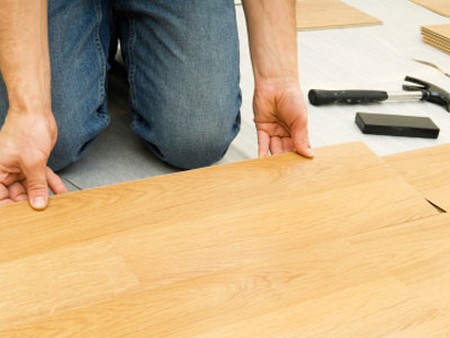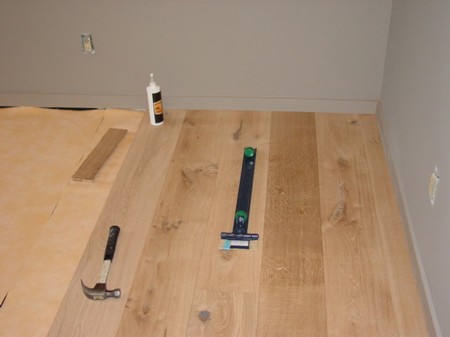Wooden floors are the ‘in thing’ at the moment, but they are not new by any means! What is new however, is the laminate floor. Popular demand for a wooden floor at a cheap price has led manufacturers to develop a flooring from a substrata (either MDF or condensed chipboard) approximately 8-9mm thick with a 2mm thick veneer surface which gives the appearance of a very hard wooden finish.
Wooden floors have long been admired and sought after, but have always been the preserve of the relatively affluent because of their expense. Laminate flooring has brought wooden floors to the masses. They are a highly popular choice – and I think in some ways a healthier choice than fitted carpets. It’s easier to clean a laminate floor and it doesn’t play host to dust mites, which are particularly problematic to people who suffer from asthma, allergies or bronchial problems. The disadvantages are that they are not as warm and cosy as carpets. Carpets are also soft underfoot.
The boards generally come in 2 meter (6ft 6in) lengths, tongued and grooved all around, and because it is only about 10mm thick, it’s ideal for covering an existing floor. Laminate flooring is available from DIY stores and most builder’s merchants. It’s very reasonably priced, from only $8.00 per meter, which allows it to compete very favourably with fitted carpets.
Firstly, repair any damage to the existing floor and screw down any loose boards. (Check for pipes before fixing down any loo boards. Use a pilot drill and countersink bit to guide the screws.)
Ideally, I think the best way to start is to remove the skirting before you begin laying the new floor. You can lay the floor with the skirting in place, provided an 8mm clearance from the skirting is left all around the floor edge.
The new flooring is supplied with a separate foam base on a roll, approximately 6mm thick, which you simply cut to size and lay on top of the existing floor.
Lay the first board against the wall leaving an 8mm gap between the board and the wall by using pre-cut wooden spacers. Cutting a section to length, simply measure (remember the 5mm gap), mark with a square and cut with either a tenon saw or crosscut saw. Ensure that the saw is sharp. To avoid breakout, score the surface with a craft knife on the line before cutting with the saw. There shouldn’t really be any waste because off-cuts can be used. Provided there is a minimum distance of 45.5mm (18in) maintained between joints, that is. Obviously, short off-cuts may not be worth using.
Apply the glue to the end tongue only and complete the first line. Then apply the second line of boards by applying the adhesive along the length as well as the end of the tongue. The flooring is made with a tongue and groove design, which interlocks together for strength, with minimum waste.
Once positioned onto the glued tongue, the board must be tapped home using a claw hammer and a tapping block to tighten up the joints. Wipe away any excess glue that squeezes out straight away with a damp cloth.
Continue this process across the room until you have finished the floor. You may have to cut the last board along its length to fit the room (remember to allow for the wooden spacers). When the floor is finished, leave for a minimum of 6 hours to allow the adhesive to cure properly. Then remove the wooden spacers all around.
This is very important to allow the floor to expand and contract unrestricted. Finally, cut 20mm quadrant to size; apply a thin bead of glue to the skirting face of the quadrant and pin to the skirting ONLY to cover the gap all around, but still allowing the floor to move.
And remember; any spills on the floor must be cleaned immediately. To wash the surface, use a tightly squeezed mop – do not use water, otherwise the floor may swell and could be ruined.
Categories
Advertisements
Recent Articles
 How to Understand Bed Sizes – A Small Guide
How to Understand Bed Sizes – A Small Guide How to Select Some Must Have Kitchen Accessories
How to Select Some Must Have Kitchen Accessories Best Way to Change a Car Tire
Best Way to Change a Car Tire Best Way to Write an Affirmation
Best Way to Write an Affirmation Best Way to Take Charge of Your Financial Life
Best Way to Take Charge of Your Financial Life Best Way to Survive a Party When You Don’t Know Anyone
Best Way to Survive a Party When You Don’t Know Anyone Best Way to Stop Self Sabotaging Yourself
Best Way to Stop Self Sabotaging Yourself Best Way to Start Journal Writing
Best Way to Start Journal Writing Best Way to Speak with a Powerful Voice
Best Way to Speak with a Powerful Voice Best Way to Simplify Your Life
Best Way to Simplify Your Life Best Way to Respond to a Put-Down
Best Way to Respond to a Put-Down Best Way to Reduce Acne Breakouts
Best Way to Reduce Acne Breakouts Best Way to Recover from Dining Disasters
Best Way to Recover from Dining Disasters Best Way to Quit Your Job Gracefully
Best Way to Quit Your Job Gracefully Best Way to Make Your Own Website
Best Way to Make Your Own Website



Leave a Reply